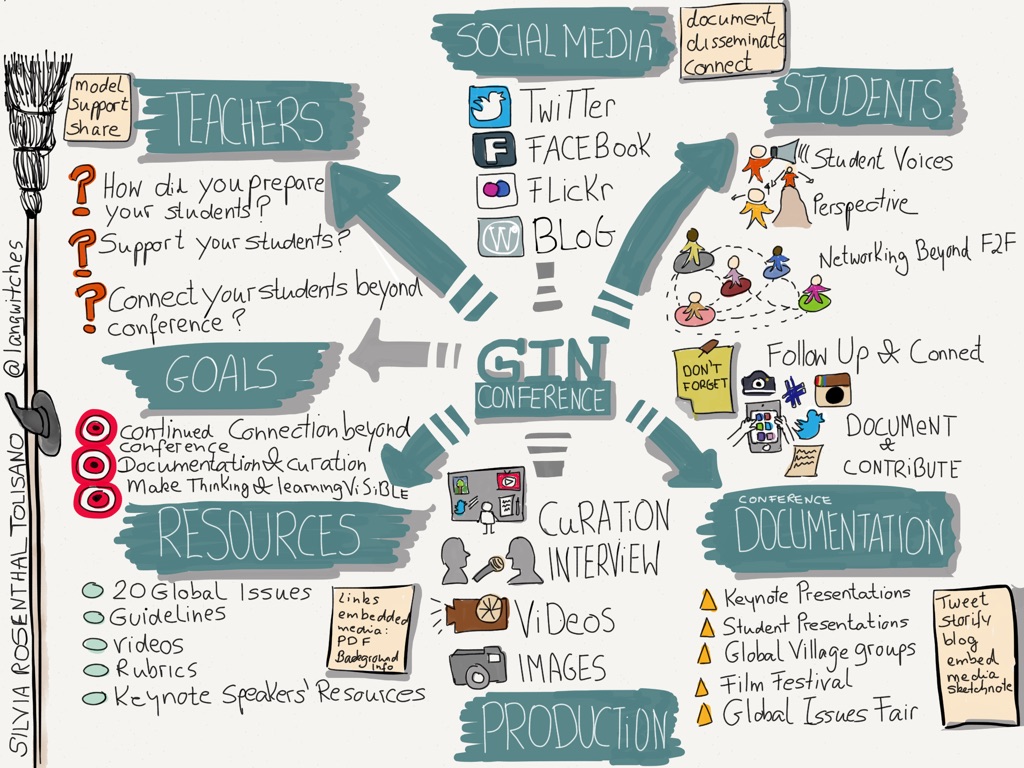Covering and Documenting a Conference via Social Media

Transforming traditional conference experiences?… learning collaboratively in physical spaces…socially… synchronously… face to face… experiences that spill over into asynchronous learning over geographic distances, time zones and time periods?…. conference archives… conference (Institutional) memories…
Those thoughts and questions have been floating around in my head for a while now and it is interesting to see how, since 2010, they have evolved and developed.
- Attending a Conference in 2010
- Twittering at a Conference
- Documenting Conferences: Blog and Twitter Styl
- New Forms of Learning: How to Participate in a Conference 2.0 Style?
As part of the AASSA team, I will be traveling to the GIN conference (Global Issues Network.) being hosted by Asociacion Escuelas Lincoln in Buenos Aires, Argentina.
GINs are groups of students and teachers, working internationally, to develop solutions for global issues. GINs challenge students and teachers to immerse themselves in a chosen issue and to interact with peers and other international collaborators to create networks, think and act critically, creatively, and innovatively toward creating solutions to address real-world global issues. The key ideas are based on the book High Noon- 20 Global Problems, 20 Years to Solve Them by Jean Francois Rischard
My job, as the Social Media Coordinator, will be to “cover” the conference. I will be tweeting, blogging and documenting the work, collaboration, vision and learning taking place during the three days in Buenos Aires.
The job of a Social Media Coordinator at an educational conference (for teachers or students) is a new concept. I am sure that many participants and even organizers are not quite sure what my role is about?
Goals
Tech & Learning Newsletter
Tools and ideas to transform education. Sign up below.
One goal is to share resources and what is going on with students and schools who are not physically present in order to connect them and their projects.
The documentation part is also at the forefront to make sure that the conference workshops, film festival and connections made do not end and are not limited to the actual days and people present. How will students take back what they learned, created and planned? How will what happens AFTER the conference be shared and connected?
- Continued connections beyond the conference
- Documentation and curation (“Digital curation is the selection, preservation, maintenance, collection and archiving of digital assets. Digital curation establishes, maintains and adds value to repositories of digital data for present and future use.” via Wikipedia)
- Making thinking and learning at the conference visible
Resources
Resources shared and produced at the conferences need to be curated (searched for, selected, tagged, categorized, archived and made accessible)
- links (external/internal links)
- embedding media (of produced and shared content)
- background info
Production
Create/produce by using and remixing a variety of media
- images
- videos
- interview
- curation platform (tweet, blog,
Conference Documentation
- tweet
- storify
- blog
- multimedia
- sketchnotes
I am also looking at documenting and archiving the conference from the following angles:
Teachers
How can teachers model for, support students and share their own unique perspective of the conference with students and other educators?
- How do teachers prepare their students to be successful participants at the conference?
- How can teachers support students at the conference?
- How will teachers help connect their students beyond the conference with other students, experts, organizations and a global authentic audience?
Students
Students are part of the overall conference crowdsourced documentation team to connect with and disseminate to each other and a global audience via social media
- Students contribute their unique perspective.
- Students voice representation.
- Students start building a global network beyond a face to face network.
- Students document in a variety of media in order to contribute to a larger pool of resources
- Students see an amplified vision of an “awareness-research-learn-present-action” process that does not end with the end of the physical conference, but continues to play a significant role with follow-up documentation and connections.
What are some other considerations and examples for educational conference documentation? How do we answer the questions I started out with?
- How do we transform traditional conference experiences through Social Media, documentation and archiving?
- How can physical conference learning experiences spill over into asynchronous learning over geographic distances, time zones and time periods?
- How do we produce conference archives (as part of a crowdsourced effort) and conference (Institutional) memories?
cross posted at langwitches.org/blog
Silvia Tolisano is a Curriculum21 faculty member, author of the book Digital Storytelling Tools for Educators and founder of the Around the World with 80 Schools project. Read more at http://langwitches.org/blog.
